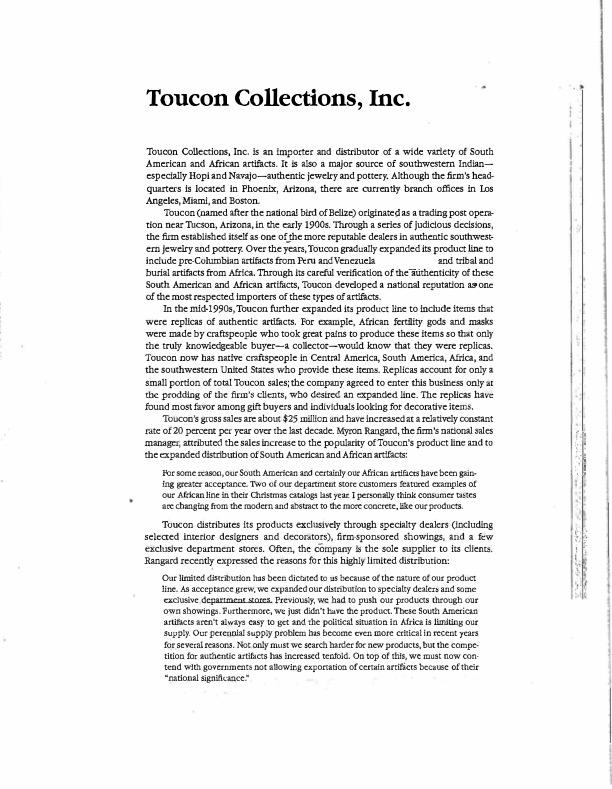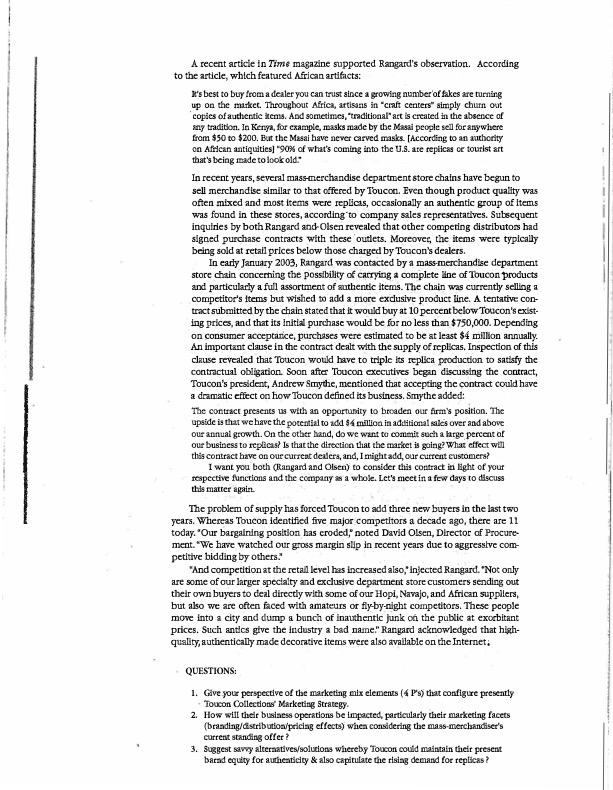Need the three questions at the end answered.


Toucon Collections, Inc, is an importer and distributor of a wide variety of South American and African artifacts. It is also a major source of southwestern Indianespecially Hopi and Navajo-authentic jewelry and pottery. Although the firm's headquarters is located in Phoenix, Arizona, there are currently branch offices in Los Angeles, Miaml, and Boston. Toucon (named after the national bird of Bellze) originated as a trading post operation near Tucson, Arizona, in the early 1900 s. Through a series of judiclous decisions, the firm established itself as one of the more reputable dealers in authentic southwestern jeweiry and potrery. Over the years, Toucon gradually expanded its product line to include pre-Columbian artifacts from Peru and Venezuela and tribal and burial artifacts from Africa. Through its careful verification of the auithenticity of these South American and African artifacts, Toucon developed a national reputation as one of the most respected importers of these types of artifacts. In the mid-1990s, Toucon further expanded its product line to include items that were replicas of authentic artifacts. For example, African fertality gods and masks were made by craftspeople who took great palns to produce these items so that only the truly knowiedgeable buyer - a collectoc-wowd know that they were replicas. Toucon now has native craftspeople in Central America, South America, Africa, and the southwestern United States who provide these items. Replicas account for only a small portion of total Toucon sales; the company agreed to enter this business only at the prodding of the firm's clients, who desired an expanded line. The replicas have found most favor among gift buyers and indivlduals looklng for decorative items. Toucco's gross sales are about $25 mallion and have increased at a relatively constant rate of 20 percent per year over the last decade. Myeon Itangand, the firm's national sales manager, attributed the sales increase to the popularity of Touccn's product line and to the expanded distrlbution of South American and African artlfacts: For some utason, our South American and certainly oue African artificts have been gsiiing greater acceptance. Two of our deparement stote customers seatured cxamples of our African line in their Chatstmas eatalogs last year I personally think coasumer tastes ate changing from the roodern and abstrace to the moee concrete, Eke our peoducts. Toucon distributes its products exclasively through specialty dealers (including selected interior designers and decorstors), firm-sponsored showings, and a few exclusive department stores. Often, the company is the sole supplier to its clients. Rangard recently expressed the reasons for this highly limited distribution: Oar limited discribusion has been dictuted to as because of the nacuar of our product line. As aoceptance grew, we expanded our distribution to specialty deaters and some exclusive department stares. Previousis, we had to push ous products through our own showings. Furthermore, we just didn't kure the product. Tbese South American artifices aren't always easy to get and the political situation in Africa is limiting our suppty. Out perennial supply problem bas become eren more critical in recent years for severat reasons. Not anly must we search harder for aew products, but the competition for zuthentic artifices has inereased tenfold. On top of this, we must now contend whth governments not allowing exporation of certafin artificts because of their "national significance." A recent articie in Time magazine supported Rangard's observation. According to the article, which featured African artificts: I's best to buy trom a dealer you can trust since a growing number' of fakes are turning up on the matkec. Throughout Africa, attisuas in "craft centers" simply churn out copies of authentic items. And sometimes, "traditioaal" att is created in the absence of sny tradition. In Kenga, for example, masks made by the Masai people sell for anywhere from $50 to $200. But the Mzsai have aever carved masks. [According to an warherity on Affean antiquities] "go\% of what's coming into the U.S. ate repicas ce tourist art that's being made to look old." In recent years, several massmerchandise department store chains have begun to sell merchandise similar to that offered by Toucco. Even though product quality was often mixed and most items were replicis, occasionally an authentic group of items was found in these stores, according to company sales representatives. Subsequent inquiries by both Rangard and- Olsen revealod that other competing distributors had signed purchase contracts with these outlets. Moreovee, the items were typically being sold at retail prices below those charged by Toucon's dealers. In early January 2003, Rangard was contacted by a mass-merchandise department store chain concerhing the possibility of carrying a complete line of Toucon products and particularly a full assortment of suthendic items. The chain was currently selling a competitor's items but wished to add a more exdlusive product line. A tentative contract submitted by the chain stated that it would buy at 10 percent below Toucon's existing prices, and that its initial purchase would be for no less than $750,000. Depending on consumer acceptarice, purchases were estimated to be at least $4 million annually. An important clause in the contract dealt with the supply of replicas. Inspection of this clause revealed that Toucon wotld have to trlple its replica paoduction to satisfy the contractual obligation. Soon after Toucon executives began discussing the contract, Toucon's president, Andrew Srnythe, mentioned that accepting the contract could have a dramatic effect on how Ibucon defined its business. Smythe added: The contract presents us with an opportusity to brcaden our firm's position. The upside is that we have the porential to 16d$4 million in adtitional sales over and above ous annual growth. On the other hand, do we want to commit such a harge percent of our business to replicas? Is that the difection that the market is going? What effect will this conttact have on our curreat delers, and, I might add, our current customers? I want you both (Rangaad and Olsen) to consider this contract in light of your respective functions and the company as a whole. Let's neet in a few days to discuss this matter again The problem of supply has forced Toucon to add three new buyers in the last two fears. Whereas Toucon identified five major competitors a decade ago, there are 11 today. "Our bargaining position has eroded," noted David Olsen, Dlrector of Procurement. "We have watched our gross margin sllp in recent years due to aggresslve competitive bidding by others." "And competition at the retall level has increased also, " injected Rangard. "Not only are some of our larger specialty and exclusive department store customers sending out their own buyers to deal directly with some of our Hopi, Navajo, and African suppllers, but also we are often faced with amateurs or fly-by-night competitors. These people mowe into a city and dump a bunch of inauthentlc junk on the public at exocbitant prices. Such antics give the industry a bad name." Rangard acknowledged that highquality, authentically made decorative items were also avallable on the Internet; QUESTIONS: 1. Give your perspective of the marketing mix elements (4Ps ) that configure presently 'Toucon Collections' Varketing Strategy. 2. How will their busiaess operations be impacted, particularly their markecing facets (beasding/assributiosipricing effects) when considering the mass-merchandiser's current standing offer ? 3. Suggest savy alternatives/solucions whereby Toucon could maintain theit present batad equity for authensicy \& also cspitulate the risiag demand for tepticas








